Dark Pools in Cryptocurrency - Crypto Academy / S5W8 - Homework Post for @fredquantum
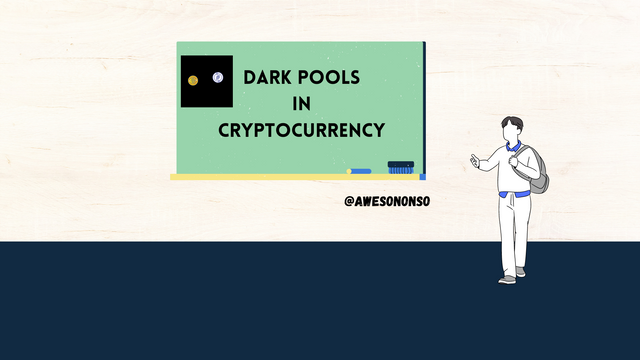

Introduction

Cryptocurrencies are popular for their decentralized nature and anonymous transactions. A lot of developments have been made to improve this privacy feature such as the development of Privacy coins and the MimbleWimble protocol. In addition to these, the crypto space has began to adapt the concept of Dark Pools for a much more higher level of privacy and bigger trading benefits.
It has been a clear lecture on the topic by professor @fredquantum with the necessary concepts explained. Without further ado, I will properly attempt the task given by the professor.

1. Discuss Dark Pools in Cryptocurrency in your own words. How does dark pool works?

The concept of dark pools is not a new one. Dark pools have been in use long before the advent of cryptocurrencies. A dark pool is simply a private place or platform for performing financial exchanges away from the eyes of the general public. Due to this privacy feature of dark pools, it was only a matter of time before the concept was introduced into the crypto business.
Crypto Dark pools are essentially separate private venues for exchanging crypto assets different from the general exchange venue. These Dark pools are avenues for traders to place large crypto orders while still remaining anonymous to the public. In essence, we can view it as a separate exchange platform for whales and institutional players in the crypto business.
How Crypto Dark Pools Work
Most crypto dark pools work by allowing traders to place limit orders of huge amounts. Limit orders are basically orders set at a predetermined price by the trader. Normally, limit orders would appear on the public order book of the exchange but in the case of dark pool orders, they do not appear on the public order book. The order book in this case is said to be separate and invisible. This makes the intentions of whales unknown to the public and so prevents people from making hasty trading decisions that would affect the market. In turn, the orders of whales would be filled at a favorable price.
When traders place these large orders, they get them matched to orders at the same price. The placing and matching of these orders is regarded as Block Trading because large amounts of the asset are bought and sold. Given the fact that the dark pool is meant for larger orders, there is always a minimum amount required for trades to be placed. Since the orders are filled at a predetermined price, slippage is avoided. Also, with dark pools, the traders can only see their own orders and not the orders of others in the pool.

2. Discuss any crypto exchange that offers a dark pool. How does its dark pool work?

A popular exchange that offers the dark pool service is Kraken. Founded in 2011, Kraken is a US-based crypto exchange. The exchange is known to be the first to offer the dark pool service in 2016. The Dark Pool started with just Ethereum but in 2021, Kraken launched a Bitcoin dark pool as well.
In order to place orders in Kraken's Dark pool, traders have to meet certain requirements which I will mention in the next question. If the requirements are met, the trader can go ahead and place a limit order on the Kraken dark pool platform for an extra fee. This limit order is then matched with other limit orders at the same price level. Market orders are not allowed because there is no order book for the traders to view the current price of the asset and because these types of orders are prone to slippage.
Note: The process of matching these limit orders is known as crossing or cross trading because the trade is not recorded in the order book.
Due to the anonymity and the fact that the trading fees are the same for a particular pair, there is no way to know if a trader is a market maker or market taker.
At the time of writing this, the Kraken Dark pool is unavailable.
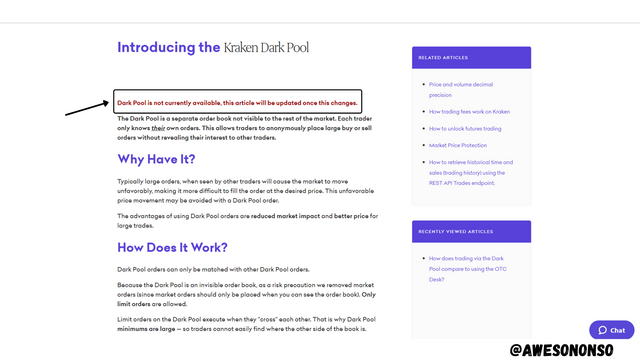

3. What are the supported assets on the dark pool mentioned in (2) above? What are the requirements for getting involved in dark pool trading on the platform? Is there any fee attracted? Explain.

Supported Assets on Kraken's Dark pool
Like I mentioned before, the assets that are currently supported on the Kraken Dark pool are Bitcoin and Ether. The pairs for these assets are;
BTC
- BTC/CAD
- BTC/EUR
- BTC/GBP
- BTC/JPY
- BTC/USD
ETH
- ETH/CAD
- ETH/EUR
- ETH/GBP
- ETH/JPY
- ETH/USD
There is also a Bitcoin and Ether pair which is ETH/BTC.
Requirements for getting involved in Kraken's dark pool
According to Kraken, these are the requirements for getting involved in the dark pool;
- Users must have been verified up to Pro Level on the exchange.
- The Users can only place limit orders as market orders are not allowed.
- The minimum amount for a BTC pair order is approximately $100,000.
- The minimum amount for an ETH pair order is approximately $50,000.
Fees Attracted in Kraken's Dark Pool
The Fees on the Dark pool are determined by a user's 30-day trading volume. Kraken claims that the more a user trades on the exchange (dark pool and otehrwise), the lower the fees they would pay on the dark pool. In general, the fees range from 0.20% to 0.36%.

4. For the chosen dark pool, give a brief illustration of how to perform block trading on the platform. (Screenshots required).

To perform a block trade on the Kraken platform is pretty straightforward. First we need to create an account on the exchange which I have done below;
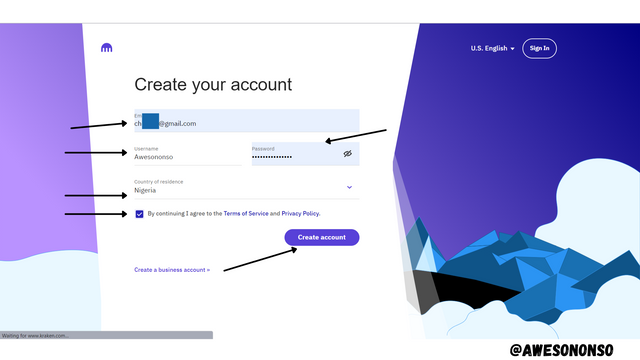
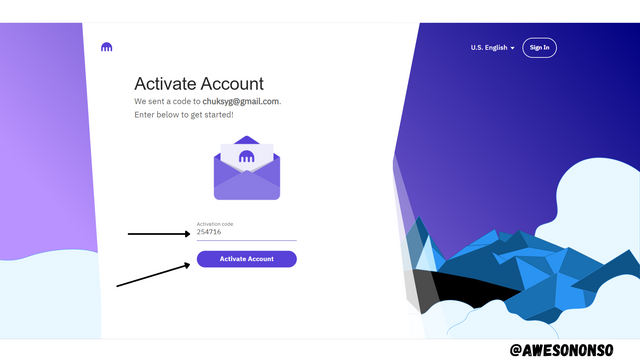
To place the trade, follow the steps below;
Step 1: Click on the Trade tab after signing in.
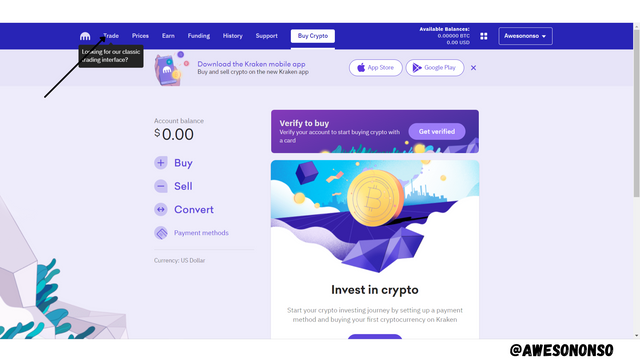
Step 2: Under New Order, switch to the Advanced tab. Then click on the Pair search button to find the dark pool pairs. The dark pool pairs should be listed under Darkpool.
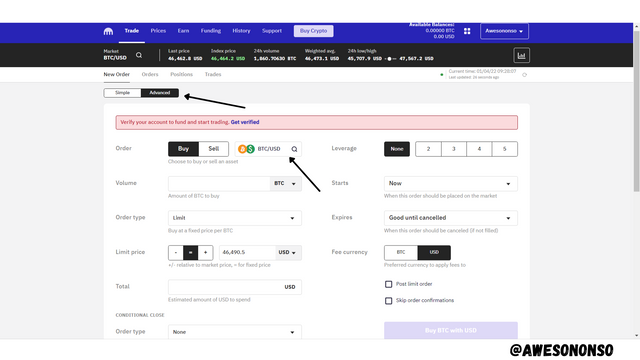
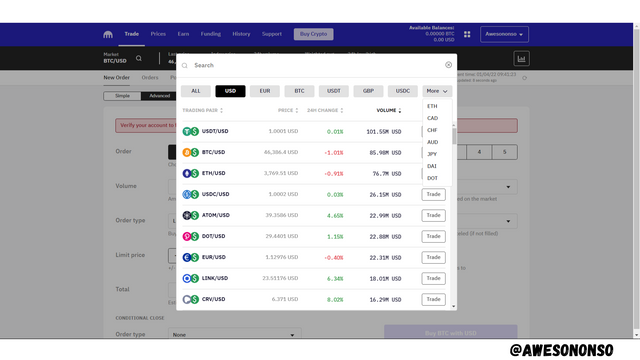
Due to the fact that the Dark pool is currently unavailable on the Kraken exchange, we cannot see this option. Below is an image of what this used to look like when the dark pool was available.
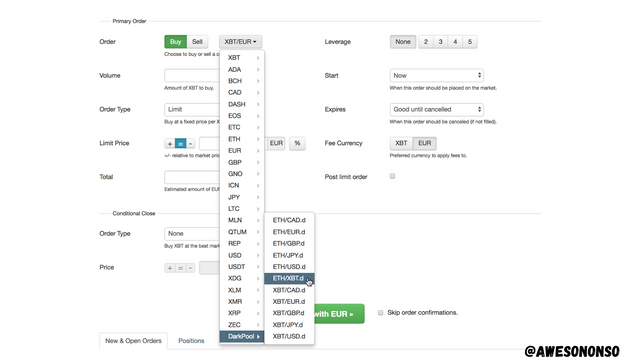

5. What's your understanding of the Decentralized dark pool? What do you understand by Zero-Knowledge Proofs?

A Decentralized dark pool is, in general, the same concept with a regular centralized exchange dark pool but with a few differences in functionality. A decentralized dark pool is one that allows traders to privately place trades of large magnitudes without the intervention of a third party. This means that orders placed and executed with a decentralized dark pool are not just unknown to the public but also unknown to any facilitator or intermediary. Decentralized dark pools are therefore absolutely private.
Unlike regular decentralized trading protocols, a decentralized dark pool does not depend on liquidity pools for trades to be executed. This type of dark pool depends on the use of Atomic swaps which involves peer-to-peer transfers across different blockchains. This function helps facilitate trades between a pair that would have normally been illiquid as the trade would be between two parties at a predetermined price. This, in turn, prevents slippage and any outstanding market effect.
When an order is placed, it is broken into much smaller pieces ready to be matched. Different nodes then receive these pieces and compete to match them. Matched pieces are recorded while the remaining unmatched ones are eventually matched until the entire order is complete. The nodes that match these transactions are rewarded with the fees associated with the transaction.
For a higher level of authentication, decentralized dark pools can use the zero-knowledge proof technology in their operation. I will explain this further below.
Zero-Knowledge Proofs
Zero-Knowledge Proof (also known as Zero-Knowledge Protocol or ZKP for short), is a type of encryption and verification protocol that was first described by Shafi Goldwasser, Silvio Micali, and Charles Rackoff in 1985. It involves proving that a statement or piece of information is true without revealing further details about it. It makes information and communication very secure and yet very authentic.
The Zero-Knowledge Proof happens between two parties. The first is the prover who has the information but needs to prove so and the second is the verifier who verifiers if the prover actually has the said information.
Any Zero-Knowledge proof must have the following properties;
- Completeness: If the prover has the information, then he should be able to convince the verifier that he does.
- Soundness: If the prover does not have the information, then the verifier must be able to remain unconvinced of the fact.
- Zero-Knowledge: The verifier should not know the details of the information but just that the prover has it or not.
Using the Zero-Knowledge protocol on a decentralized dark pool, users can perform transactions without revealing balances or transactions prices and volumes. The nodes involved in matching orders can do so without even knowing the details of the orders.

6. State one decentralized dark pool in cryptocurrency and discuss it. How does it work?

A very popular project that offers a decentralized dark pool is The Ren Protocol. Ren protocol was founded in 2017 by Taiyang Zhang and Loong Wan as the Republic protocol but was renamed to Ren Protocol in 2019.
According to the Republic Protocol Whitepaper, the Ren (Republic) protocol is a decentralized dark pool project that was one of the first to apply atomic swaps in the Dark pool concept. When an order is placed in the Dark pool, it is broken down using Shamir Secret Sharing and then distributed to a network of Dark nodes. This protocol then deploys two Ethereum smart contracts which are The Registrar and The Judge for the rest of the process.
After the order is fragmented and distributed among the darknodes, the Registrar prevents them from getting reconstructed by arranging the nodes in a manner that would make an attempt to do so very difficult. The nodes then perform various computations to match the fragments with that of another order. The Judge verifies the integrity of the computations using a Zero Knowledge Proof without revealing any information about them. After the fragments of two orders have properly been matched, an Atomic Swap is initiated for the crypto assets.
From my research, after Republic protocol rebranded to Ren Protocol, they shifted their focus to interoperability. Currently, there are no other projects properly offering a decentralized dark pool.

7. Compare a crypto centralized exchange dark pool with a decentralized dark pool. What are the distinctive differences?

| Kraken(Centralized) | Republic protocol(Decentralized) |
|---|---|
| Users here need to get to a higher KYC level to participate. | There is no KYC requirement for decentralized. |
| Orders are not broken down to fragments. | Orders are broken down to various smaller fragments. |
| There are no nodes involved. | Nodes are involved in the process. |
| Smart contracts are not used here rather a third party facilitates the trades. | Smart contracts are used here. |
| The Exchange can view the orders because. | Absolutely no one can view the orders here. |
| Orders are crossed in a centralized dark pool. | An Atomic Swap takes place between the traders in a decentralized dark pool. |

8. Research any recent huge sale in any market in the crypto ecosystem and how it has affected the market. What difference would it have made if the dark pool was utilized for such sales?

On the 3rd of November, 2021, there was a sell off of 246 BTC (worth about $15 million at the time) on Coinbase as reported by CoinMarketCap. This sell off was placed with a market order and it caused the price of Bitcoin to fall from $62,500 to $60,000.

I would say that the whale placed a market order because he knew that if other traders saw a limit order on the order book they would begin to sell off and his trade would not be executed. Although, the fall was short-lived due to a large amount of buy limit orders at the 60k level, this sell off gives us an idea of how huge sales can affect the market. The massive sell off alone would wipe off millions of dollars from the market cap. Additionally, when regular traders see such trades in the order book, the begin to sell off their assets as well causing the price to fall even more.
A dark pool should have been used by the whale to execute the transaction. If a dark pool was used, the whale would have had the chance to place a limit order at a convenient price level. The limit would not be seen by other traders and so there would be no sell off due to fear. The trader would have had his order executed at his convenience and the price of BTC would not have fallen so much.

9. In your own opinion, qualitatively discuss the impacts of trades carried out in the dark pool on the market price of an asset. (At least 150 words).

Normally, when large orders appear on the order book they cause traders to act on sentiments. Large buy orders cause traders to buy that asset pumping money into its market cap and driving the price up. Similarly, large sell orders cause traders to sell that asset draining money from its market cap and driving the price down. This is simply an application of demand and supply where if the demand is higher than the supply the price would increase and if the supply is higher than the demand, the price would fall.
When it comes to the dark pool, this effect does not take place. As we have stated before, trades carried out in the dark pool are not visible on the order book. This means that other traders cannot see such large trades and so will not act on sentiments. In the end, there will not be significant changes in the price of the asset because demand and supply would be fairly equal.
Also, given the fact that the trades placed in dark pools have a large magnitude, we would normally expect such trades to affect the price of the asset on their own. A large sell trade of say 5000 BTC would greatly outmatch the smaller orders we see on the order books of exchange which is normally supposed to make the supply more than the demand and then cause the price to fall. However, with the use of a dark pool, a large sell order is filled when it is matched with a buy order of the same magnitude. This balances the forces of demand and supply and so does not affect the price.

10. What are the advantages and disadvantages of Dark pool in Cryptocurrency?

Advantages
The Dark pool helps prevent slippage because the orders are placed at a desired price with Limit orders.
The Dark pool helps facilitate direct trades between assets that would have normally been illiquid.
The use of the dark pool hides the intentions of whales from the public. This would reduce sentiment and prevent any huge price movements.
The use of dark pools adds an extra level of privacy for traders.
Disadvantages
The use of the dark pool places smaller traders at an unfair disadvantage. This is because whales would have the privilege to place orders at a price level that is different from the market price and have it executed at that price.
When whales begin to use dark pools, the liquidity in the main market would greatly reduce.
Due to the fact that the order book is invisible, there is a lack of transparency.

Conclusion

The dark pool is quite useful as we have seen it being successfully applied in the financial markets. Although the technology has proven to be useful, it is still not very functional in the crypto world. I believe that a couple of developments can be made so that the concept would become fully functional in the crypto space. Given the fact that cryptocurrencies have the anonymity feature, this dark pool concept would help improve this feature a lot.
I believe that decentralized exchanges are the future. Especially after privacy coins regulations and ban. And while Crypton no KYC decentralized exchange from Utopia p2p listed Monero https://crp.is/exchange/xmr_usdt I've understood that we can keep calm. As it still can be accessed from any country no matter what regulations there are. And there's no risk as you're fully anonymous there.